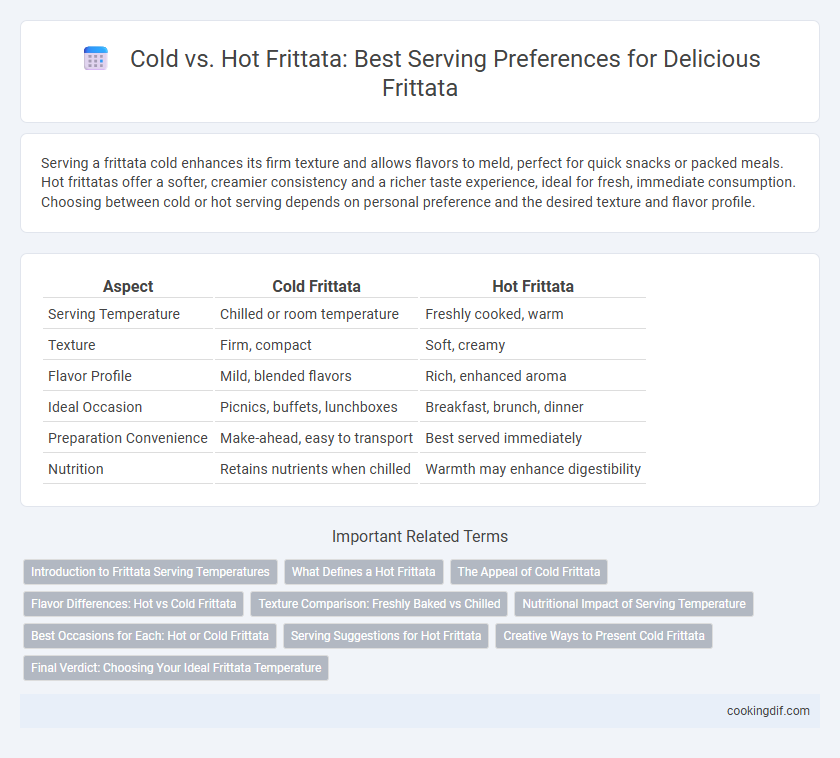Serving a frittata cold enhances its firm texture and allows flavors to meld, perfect for quick snacks or packed meals. Hot frittatas offer a softer, creamier consistency and a richer taste experience, ideal for fresh, immediate consumption. Choosing between cold or hot serving depends on personal preference and the desired texture and flavor profile.
Table of Comparison
| Aspect | Cold Frittata | Hot Frittata |
|---|---|---|
| Serving Temperature | Chilled or room temperature | Freshly cooked, warm |
| Texture | Firm, compact | Soft, creamy |
| Flavor Profile | Mild, blended flavors | Rich, enhanced aroma |
| Ideal Occasion | Picnics, buffets, lunchboxes | Breakfast, brunch, dinner |
| Preparation Convenience | Make-ahead, easy to transport | Best served immediately |
| Nutrition | Retains nutrients when chilled | Warmth may enhance digestibility |
Introduction to Frittata Serving Temperatures
Frittatas can be served hot or cold, each option highlighting distinct flavor profiles and textures. When served hot, the frittata is creamy and tender, emphasizing the richness of the eggs and fillings like cheese and vegetables. Cold frittatas offer a firmer texture and intensified flavors, making them ideal for convenient, make-ahead meals or picnic dishes.
What Defines a Hot Frittata
A hot frittata is characterized by its warm, tender texture and freshly melted cheese, enhancing the flavors of ingredients like eggs, vegetables, and meats. Serving it hot ensures optimal taste and aroma, as heat intensifies the savory blend and preserves the dish's creamy consistency. This contrasts with a cold frittata, which firms up and develops a denser texture, often favored for portability and convenience rather than immediate flavor impact.
The Appeal of Cold Frittata
Cold frittata retains its rich, layered flavors and dense texture, making it an ideal make-ahead option perfect for picnics, brunches, and quick lunches. Its versatility allows for easy slicing and serving, enhancing convenience without sacrificing taste. The appeal of cold frittata lies in its ability to meld ingredients like herbs, cheese, and vegetables, creating a harmonious flavor profile that is even more pronounced when chilled.
Flavor Differences: Hot vs Cold Frittata
Hot frittata offers a richer, creamier texture as the eggs remain soft and the flavors meld seamlessly when freshly cooked. Cold frittata, served chilled or at room temperature, provides a firmer bite with more distinct, concentrated flavors from ingredients like cheese, herbs, and vegetables. Serving temperature significantly influences the taste profile, with hot enhancing umami and melt-in-mouth qualities, while cold emphasizes fresh, bold notes.
Texture Comparison: Freshly Baked vs Chilled
Freshly baked frittatas showcase a light, fluffy texture with a slightly crispy edge that enhances the eating experience. Chilled frittatas become denser and firmer, allowing flavors to meld but sacrificing some of the initial softness. Texture preferences often guide serving choices, as warm frittatas appeal to those seeking creaminess while cold versions suit grab-and-go meals.
Nutritional Impact of Serving Temperature
Serving a frittata hot preserves its moisture and enhances the bioavailability of certain heat-sensitive nutrients like vitamin B6 and folate. When served cold, the frittata's texture firms up, which may slightly reduce the absorption of fat-soluble vitamins such as vitamin D and E. The glycemic index of accompanying ingredients can be affected by temperature, influencing blood sugar response depending on whether the frittata is served warm or chilled.
Best Occasions for Each: Hot or Cold Frittata
Hot frittatas are ideal for breakfast or brunch gatherings, offering a warm, comforting dish that pairs well with fresh herbs and melted cheese. Cold frittatas serve perfectly as portable meals for picnics, lunchboxes, or casual snacks, maintaining robust flavors even when refrigerated. Choosing between hot or cold depends on the event's setting and convenience, with hot suited for formal meals and cold for on-the-go eating.
Serving Suggestions for Hot Frittata
Hot frittata is best served immediately after cooking to retain its fluffy texture and rich, melted flavors. Ideal serving suggestions include pairing it with fresh herbs like basil or chives, a side of roasted vegetables, or a light salad to complement the warm, savory profile. For enhanced taste, drizzle with olive oil or a dollop of sour cream just before serving.
Creative Ways to Present Cold Frittata
Cold frittata offers versatile serving options that enhance its appeal at picnics, brunches, or buffet-style meals. Creative presentations include slicing it into bite-sized squares for easy finger food, using colorful vegetable toppings to add visual interest, or layering slices between fresh greens and spreads in sandwiches or wraps. Serving cold frittata with complementary dips like herb-infused yogurt or spicy salsa further elevates flavor and texture, making it a crowd-pleasing choice.
Final Verdict: Choosing Your Ideal Frittata Temperature
Serving preferences for frittata vary widely, with hot servings highlighting a fluffy texture and enhanced flavor release, while cold frittata offers convenience and a firmer slice ideal for picnics or packed meals. The final verdict on ideal frittata temperature depends on occasion and palate: hot frittata excels in freshness and melting cheese, whereas cold frittata suits grab-and-go options with intensified, settled flavors. Understanding these contrasts helps in selecting the perfect frittata temperature tailored to specific dining experiences and personal taste profiles.
Cold vs Hot Frittata for serving preferences Infographic

 cookingdif.com
cookingdif.com